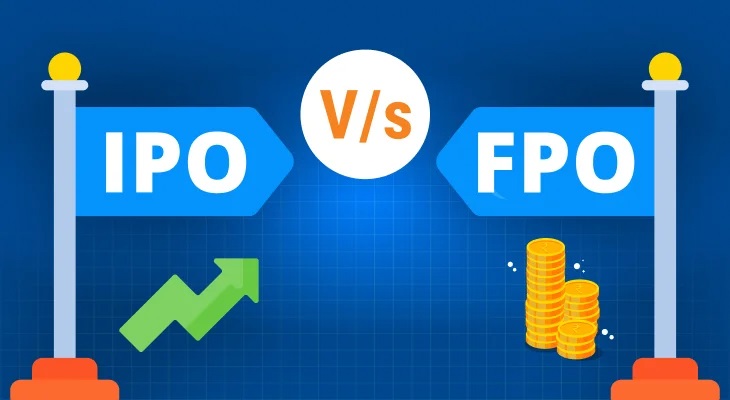Introduction
Companies can get money via the financial markets in various ways, but two of the most well-known are initial public offerings (IPOs) and follow-on public issues (FPOs). Both provide businesses with ways to get public funding, but their goals, methods, and consequences are quite different. Both businesses and investors need to comprehend these distinctions. These are a few specific examples of how IPOs and FPOs differ from one another and how to choose best ipo to buy now.
Difference Between IPO and FPO
- Definition and Objective
The first time a private firm sells its shares to the general public is during an initial public offering or IPO. By transferring its ownership from private to public, the firm could gain significant funding through the sale of shares on the stock market. An IPO’s main goal is to raise money for corporate purposes such as debt repayment, company development, or other initiatives. Additionally, it improves the business’s reputation and market exposure, which often results in improved terms with suppliers and lenders.
A Follow-on Public Offering (FPO), on the other hand, takes place when a company that is publicly traded offers more shares to the general public. Usually, FPOs are carried out to acquire additional funds after the firm has already gone public. An FPO could be asked to finance new initiatives, settle outstanding debt, or strengthen the company’s financial standing. FPOs, as opposed to IPOs, involve firms that investors are already familiar with, which may have an impact on the asking price and level of demand for the additional shares.
- Procedure and Law Enforcement Needs
Companies have to conform to the standards imposed by regulatory organisations such as the Securities and Exchange Commission (SEC) in the United States throughout the complex and highly regulated initial public offering (IPO) process. Businesses are required to generate comprehensive financial statements, submit to audits, and provide a substantial quantity of information on their management, operations, and financial standing. The purpose of this openness is to safeguard investors and provide them with the knowledge they need to make wise choices. In order to determine the first share price, oversee the share sale, and underwrite the offering, the firm needs to collaborate with investment banks.
Although they are still under regulatory review, FPOs typically go through a more simplified procedure than IPOs. The company’s track record of regulatory compliance stems from its previous listing on a public exchange, which lessens the burden of the extra disclosure procedure. Although updated financial information and filings with regulatory agencies are still required, the procedure is now faster and less expensive overall. Because of their efficiency, FPOs may be a desirable alternative for businesses trying to raise more money without going through the drawn-out process of an IPO.
- Way of Pricing
The book-building or fixed-price offering method is used as a starting share price in the system for determining the prices of an initial public offering (IPO). A book-building initial public offering (IPO) involves underwriters soliciting bids from prospective investors in order to assess demand and establish the final offer price. The goal of this procedure is to determine the best price that strikes a compromise between the interests of the investors buying shares and the firm seeking financing. Due to its reliance on market conjecture and the company’s perceived worth, the initial pricing may be difficult to understand and often causes considerable price volatility once trading starts.
Generally, the pricing method for an FPO is simpler. The market price serves as a benchmark for determining the price of the new shares since the company’s shares are already traded on the stock exchange. In order to draw in investors, the firm could issue the new shares at a discount to the going rate on the market or, if there is high demand, at a premium. In comparison to an IPO, this price clarity may make investors feel less uneasy and can provide a steadier reaction from the market.
- Views on the Market and Investor Mindset
While investor mood and market perception are important factors in both FPOs and IPOs, their effects are different. As a company’s first foray into the public markets, initial public offerings (IPOs) can cause a great deal of enthusiasm and media attention. The demand for shares may exceed supply due to oversubscription, which might result from this hype and generate substantial investor interest. But the initial excitement may also lead to increased volatility, with share values seeing sharp swings in the first few trading days.
However, since FPOs include well-known corporations in the market, they are often seen with less commotion. The company’s present financial health and historical performance have an impact on investors’ perceptions of an FPO. A firm may encounter favourable investor mood and steady demand for an FPO if it has a solid track record and compelling reasons for seeking more funding. On the other hand, the share price may have a negative response and downward pressure if the market interprets the FPO as an indication of financial trouble or inadequate management.
- Diluting the Ownership
Potential ownership dilution is a major worry for current shareholders in both initial public offerings (IPOs) and follow-on financings (FPOs). During an initial public offering (IPO), the original owners and early investors bear the brunt of the dilution when new shares are given to the public, reducing their ownership percentage. Nevertheless, the infusion of cash and the advantages of going public, such as higher liquidity and market value, often outweigh this dilution.
Dilution in a First Public Offering (FPO) refers to the process of issuing new shares in order to raise more cash and decrease the ownership proportion of current shareholders. The ratio of newly issued shares to existing shares determines the degree of dilution. Dilution may be an issue, but it may be justified if the funds collected are put to good use in order to spur development and boost the company’s total worth. It is possible to alleviate shareholder worries about dilution by outlining the planned use of the cash and showcasing possible advantages.
Conclusion
IPOs and new ipo details and FPOs, each with unique features and implications, are crucial instruments for businesses seeking to acquire cash. An initial public offering (IPO) is a company’s first foray into the public markets; it includes intricate procedures and substantial ownership structure changes. FPOs, on the other hand, provide a more streamlined and low-risk approach; they are carried out by publicly traded corporations looking for more funding. Recognising these variations facilitates knowledgeable decision-making and efficient financial market navigation for businesses and investors.
Read more ; Foreign Citizenship and Residence by Investment



